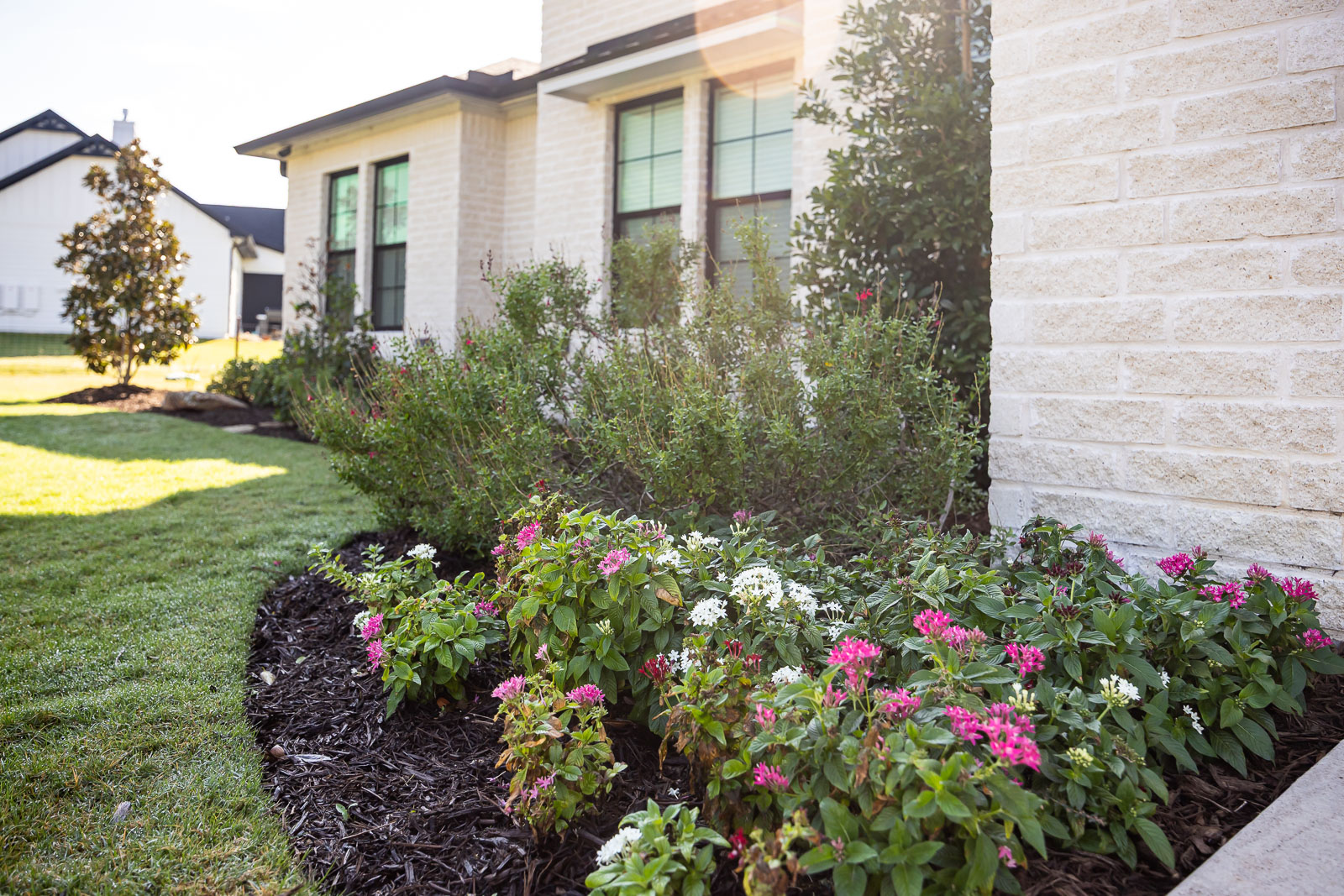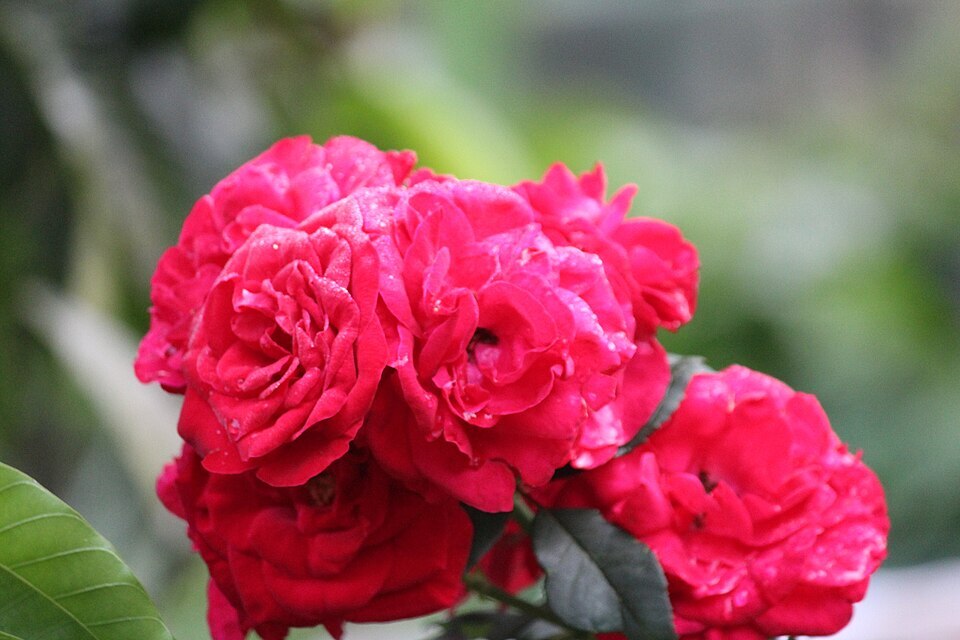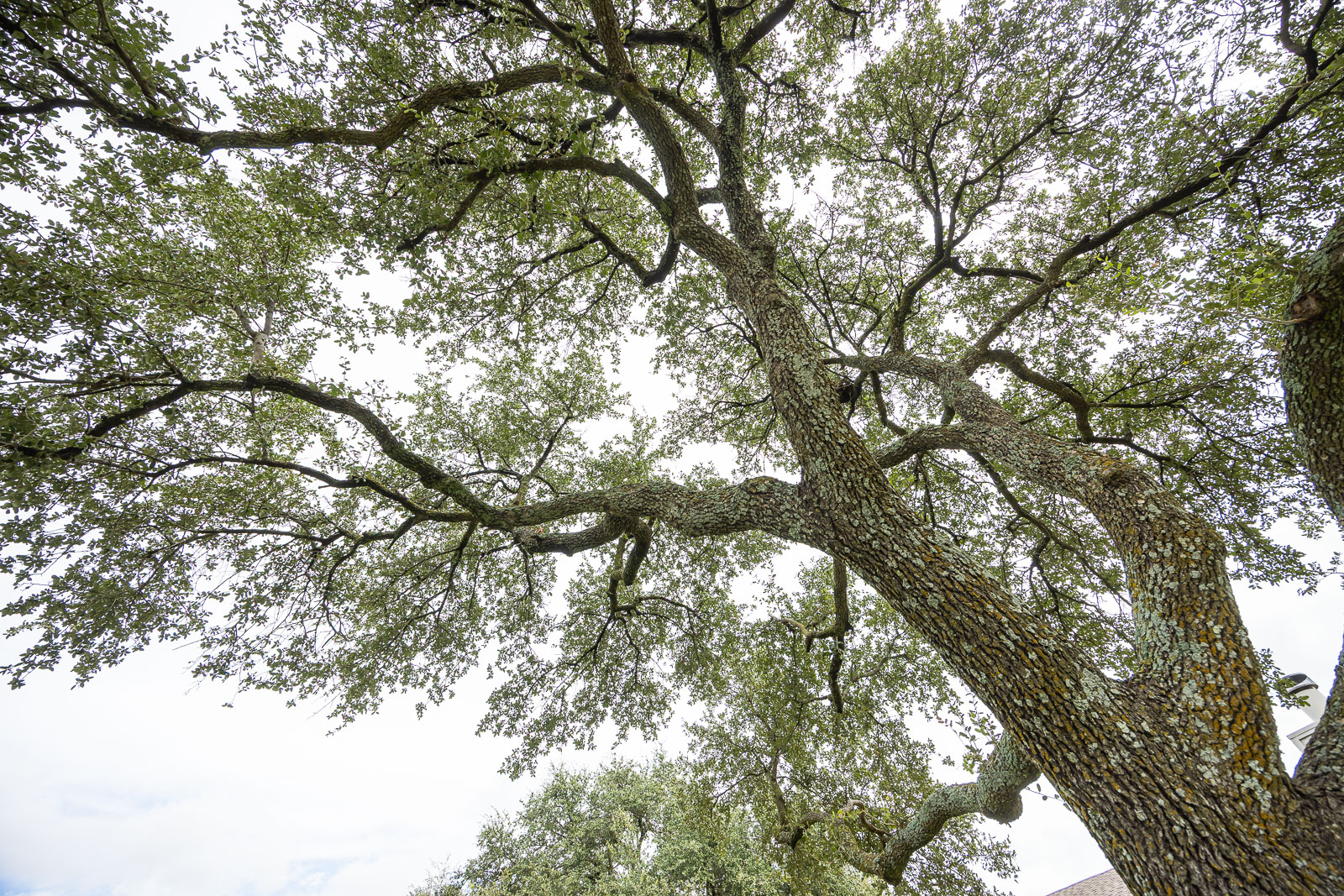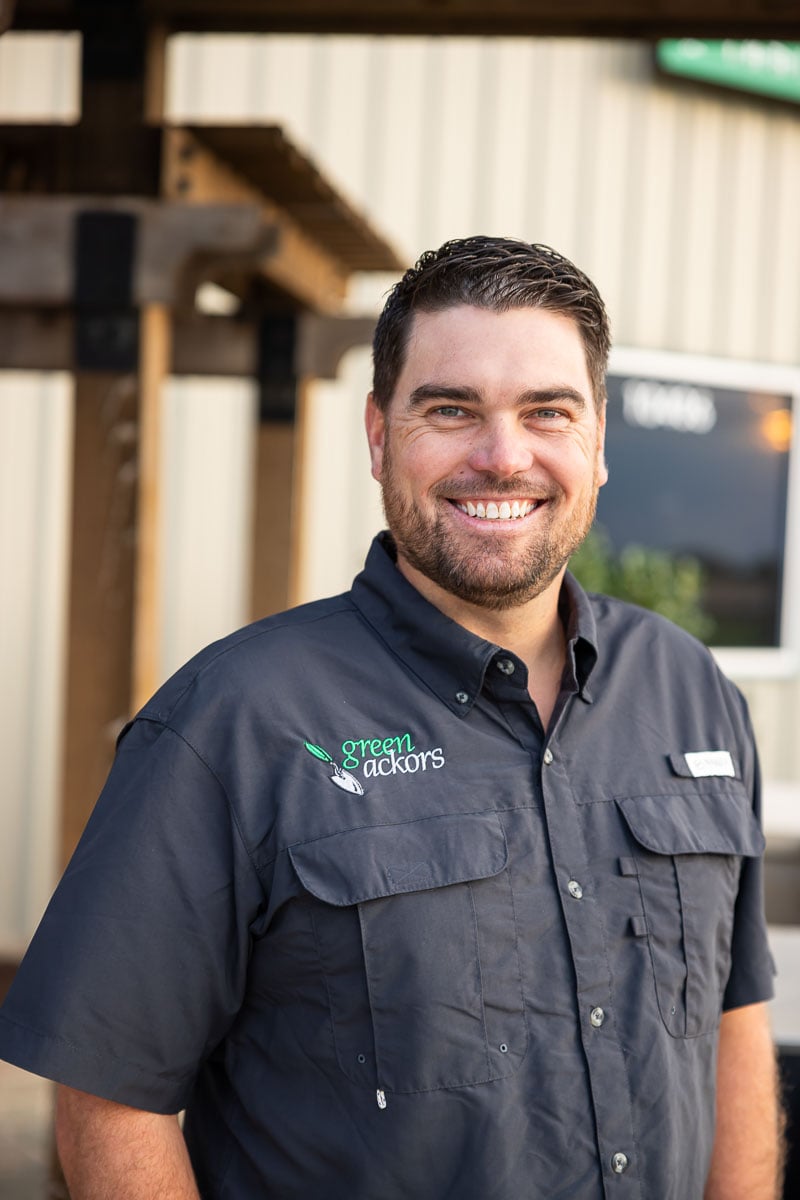
Written By Barry Marusak
You step outside, coffee in hand, ready to enjoy your yard–only to notice the grass looks a little patchy, the shrubs are overgrown, and there’s a sprinkler head geysering water onto the sidewalk. Was I supposed to handle this last week?
Keeping up with lawn care can feel like a never-ending guessing game. What needs attention now? What can wait? And how do you stay ahead of problems before they spiral out of control?
Taking care of your yard isn’t just about keeping it looking nice. It’s about protecting your home, creating a space you love, and preventing bigger (and often more expensive) issues down the road.
To make things easier, we’ve put together a simple, easy-to-follow landscape maintenance checklist for Central Texas that breaks down everything you need to do–week by week, month by month, and season by season. Whether you’re tackling it yourself or looking for professional help, this guide will help you keep your yard in top shape all year long!
Table of Contents
Why Landscape Maintenance in Central Texas Matters
Essential Yard Maintenance Tasks to Tackle
Lawn Care Checklist
Plant Health Care Checklist
Mulching Checklist
Irrigation Checklist
Seasonal Services Checklist
Seasonal Yard Care- Focus on This One Task Each Season
Benefits of Partnering with a Pro for Landscape Maintenance
Partnering with Green Ackors
Why Landscape Maintenance in Central Texas Matters
Taking care of your yard isn’t just about keeping up appearances–it’s about protecting your home, creating a space you love, and avoiding bigger issues down the road. Central Texas homeowners like yourself face unique landscaping challenges, from scorching summers to unpredictable weather swings. That’s why having a solid yard maintenance checklist is key to keeping your outdoor space thriving.
Here’s why regular residential landscaping services in Waco, TX (or at a dedicated DIY routine) should be a priority:
- Boost Your Curb Appeal and Home Value: A well-maintained landscape makes a lasting first impression and can significantly increase your property’s value. Whether you’re planning to sell in the future or simply want to take pride in your home’s appearance, a lush lawn and healthy plants can make all the difference.
- Prevent Costly Repairs: Overgrown trees, clogged gutters, and neglected lawns can lead to bigger problems, like foundation damage, pest infestations, or damage to your home. Proactive landscape maintenance helps you avoid expensive fixes before they become major headaches.
- Create a Safe & Enjoyable Outdoor Space: Your yard should be a place where your family, pets, and guests can relax and enjoy the outdoors. Proper maintenance ensures clear walkways, healthy grass, and shaded areas that make spending time outdoors more comfortable and inviting.
Keeping up with your landscaping doesn’t have to be overwhelming. Whether you prefer a hands-on DIY approach or want the convenience of a professional landscaping partner, having a maintenance plan in place will help you get the most out of your outdoor space.

Yard Maintenance in Central Texas: Essential Tasks to Tackle
Maintaining a beautiful and healthy landscape in Central Texas requires year-round care. The region’s unique climate–hot summers, mild winters, and occasional drought–means that regular upkeep is essential to keeping your yard thriving. Below is a breakdown of the most important landscape maintenance tasks, how often they should be done, and why they matter.
Lawn Care
A lush, green lawn doesn’t happen by accident. It requires proper mowing, fertilization, and disease and weed management. Here’s what Central Texas lawn care should include:
Mowing
Mowing isn’t just about keeping your lawn looking neat–it directly impacts your grass's health. Cutting grass at the correct height helps it develop strong roots, maintain moisture, and resist weeds. Cut Bermuda and Zoysia grass varieties to about an inch tall. For St. Augustine variety, keep it at around 2 inches. Follow these tips if you plan to try DIY mowing:
- Keep your mower blades sharp for a clean cut.
- Use mulching mowers to keep clippings out of landscape beds and feed your lawn nutrients.
- Choose the right mower size for your yard.
Want to dig a little deeper into the specifics of lawn mowing? Check out this blog.

Lawn Fertilization
Fertilization is the process of feeding your lawn the essential nutrients it needs to grow thick, green, and strong. Texas soil doesn’t always provide the right balance of nutrients on its own, so applying fertilizer ensures your grass gets what it needs to thrive.
There are two primary types of fertilizers used in lawn care. Granular fertilizer is applied as dry pellets that slowly release nutrients over time. It’s ideal for long-term feeding because it provides a steady supply of nutrients to the grass as it breaks down. Liquid fertilizer is applied as a spray that quickly absorbs into the grass and soil, giving an immediate nutrient boost. Liquid fertilizer can be used when grass needs a quick green-up or if you need to correct nutrient deficiencies. A well-balanced program uses both granular and liquid applications.
Fertilization is so important for a variety of reasons:
- Encourages Strong Root Growth: Proper nutrients help develop roots, making the lawn more resistant to drought and stress.
- Boosts Disease and Pest Resistance: A well-fed lawn is better equipped to fight off common lawn diseases and pest infestations.
- Prevents Nutrient Deficiencies: Without fertilization, grass can become thin, yellow, and more prone to weeds and bare patches.
- Improves Lawn Density: A thick, lush lawn naturally crowds out weeds, reducing the need for herbicides.
Lawn Edging
Edging gives your lawn that crisp, finished look by defining clean lines along sidewalks, driveways, and flower beds. Typically, a mechanical edger trims overgrown grass along hard surfaces, keeping the lawn from spilling over onto sidewalks and flower beds. Beyond aesthetics, edging prevents grass from creeping into areas where it shouldn’t be, making landscape maintenance easier in the long run.

Lawn Aeration
Over time, soil becomes compacted, making it harder for grass roots to access air, water, and nutrients. Lawn aeration helps by removing small plugs of soil to improve circulation. An aeration machine punctures small holes into the soil, loosening it and allowing deeper root growth.
Aeration enhances water absorption, reduces soil compaction, and boosts overall lawn health by allowing the nutrients from fertilization to better penetrate the root zone.
Weed, Insect, & Disease Control:
Unfortunately, weeds, diseases, and insects can quickly take over your lawn if left unchecked, competing with grass for nutrients and water. To combat weeds, insects, and disease, it is important to fertilize regularly, mow efficiently, irrigate properly, and use pre-emergent herbicides to stop weeds before they even begin to sprout. The best way to control these lawn problems is to have a healthy, thriving lawn in the first place. In severe cases, targeted treatments may be necessary.
Plant Health Care
Plant health care is all about proactive maintenance to keep your trees, shrubs, and plants strong, healthy, and looking their best. Regular care not only enhances the beauty of your landscape but also prevents costly issues down the road. When plants are neglected, they become more vulnerable to disease, pests, and environmental stressors, often leading to pricey replacements. Investing in tree and shrub maintenance in Waco, TX, ensures your landscape remains vibrant and resilient.
Trimming and Pruning
Regular trimming and pruning help maintain the shape, structure, and overall health of your plants. Shrub and hedge trimming keep plants neat and properly shaped, whether you prefer a natural or formal look. The frequency depends on the plant.
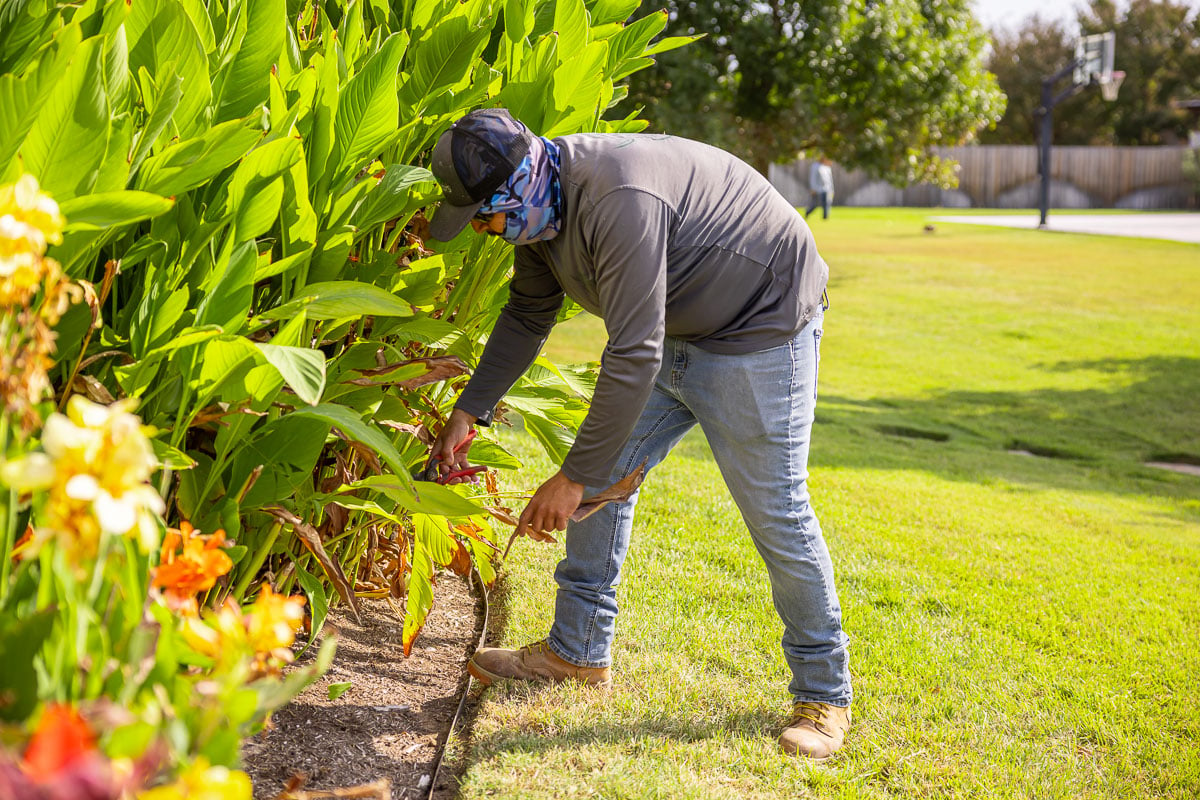
Weeding
Weeds compete with your plants for nutrients, water, and sunlight. Regular bed maintenance should include pulling or treating weeds to keep your landscape looking clean and prevent them from spreading.

Tree Trimming and Pruning
Trees need periodic trimming and pruning to remove dead or weak branches, which helps prevent storm damage and promotes healthy growth. Proper pruning can also enhance the tree’s structure and longevity.

Tree Removal and Stump Grinding
When a tree becomes a safety hazard due to disease, storm damage, or old age, removal may be necessary. Stump grinding ensures that no unsightly stumps are left behind, making space for new plantings and preventing pests from making a home.
Tree and Shrub Fertilization
Just like your lawn, trees, and shrubs need the right nutrients to stay strong. Shrub fertilization is included in most professional companies’ plant health care packages, ensuring they receive a balanced feeding throughout the year. Healthy plants are more resistant to pests, diseases, and environmental stress.
Insect and Disease Remediation
Central Texas landscapes are prone to various pests and diseases that can weaken or kill trees and shrubs. Regular inspections and treatments help identify issues early, preventing them from spreading and causing extensive damage.
Mulching
Mulching is one of the easiest and most effective ways to maintain a healthy landscape in Texas. With scorching summers and unpredictable rainfall, the right mulch helps conserve moisture, regulate soil temperature, and suppress weeds–all while enhancing the overall appearance of your property.
Applying mulch in the spring before extreme heat sets in, or in the fall to protect plant roots during temperature fluctuations, can make a significant difference in your landscape’s health. Organic mulches like native hardwood or cedar decompose over time, enriching the soil with nutrients and promoting stronger root systems.
Regular mulching for Texas landscapes not only improves plant health but also reduces the need for frequent watering and weeding, saving both time and resources.

Irrigation
A well-maintained irrigation system is essential for keeping your landscape looking its best, especially in the harsh climate of Waco, TX. Over time, sprinkler heads can break, leaks can develop, and water distribution can become uneven, leading to dry, patchy areas or overwatered spots that encourage disease and weed growth.
Irrigation system maintenance in Central Texas includes routine audits and repairs to ensure your system is functioning effectively. An irrigation audit involves checking for leaks, assessing water pressure, and ensuring each zone delivers the right amount of water to your plants. Repairs may include replacing damaged sprinkler heads, fixing leaks, or adjusting controllers to improve efficiency.
Regular irrigation maintenance not only prevents costly water waste but also protects your landscape investment.

Seasonal Services
Seasonal landscape maintenance services like fall leaf removal, garden cleanup, and post-storm cleanups ensure your property stays healthy, tidy, and visually appealing no matter the time of year.
As leaves accumulate, they can smother your grass, promote mold growth, and create a messy appearance. Removing leaves promptly helps protect your lawn’s health and keeps your property looking fresh. After winter, most landscapes need a refresh. Clearing debris and plant trimmings out of your garden beds encourages strong new growth for the season ahead.
Severe weather that we sometimes see here in Central Texas can leave behind fallen branches, scattered debris, and damaged plants. Post-storm clean-up can restore order to your landscape and prevent potential hazards.
Your Landscape Maintenance Checklist
Now that we’ve covered the essential landscape maintenance tasks, the next question is: when and how often should you complete them? Keeping up with these tasks on the right schedule ensures your landscape stays healthy and vibrant year-round. Whether it’s following a lawn fertilization schedule in Texas or planning for seasonal upkeep, a well-organized landscape maintenance checklist helps you stay on track and avoid costly issues down the road.

Lawn Care Checklist
Keeping your lawn in top shape requires consistency. By following a yard maintenance checklist, you can ensure your grass stays healthy, green, and resilient. Below is a breakdown of the key tasks to complete on a weekly and monthly basis for lawn care, as well as some common challenges to watch out for.
Weekly Lawn Care Tasks
- Mowing– Starting April 1st, mow weekly until November 1st. In December and January, mow every other week. Try for a minimum of 42 trims per year, with some lawns requiring 52. During the winter months, you don’t need to mow, but you may want to mulch-mow moderate leaf coverage weekly instead of raking and hauling it off regularly.
- Lawn Edging– Edge along sidewalks, driveways, and garden beds to keep a crisp, clean look during the main growing season (April-November)
- Weed Control– Regularly inspect for weeds and spot-treat problem areas weekly as they arise to prevent them from spreading.
- Pest & Disease Checks– Inspect your lawn for pests and fungal diseases weekly, which can quickly lead to damaged turf if left unchecked. If you find a major issue, begin treatment if necessary promptly.
Monthly Lawn Care Tasks
- Lawn Fertilization– For St. Augustine grass, apply fertilizer 4 times a year for strong, thick growth. For Bermuda and Zoysia grass, apply fertilizer 6 times a year to help the lawn stay dense and healthy. Avoid applying fertilizer in the hottest months of the year that is high in nitrogen. Lawn fertilization treatments should also have built-in pre-emergent applications to help control weeds.
- Lawn Aeration and Overseeding– Perform core aeration one time per year. We recommend spring or fall to reduce soil compaction and improve root growth. November is the perfect time to overseed your lawn.
- Irrigation System Check Up– Inspect and adjust sprinklers on a monthly schedule to ensure even water distribution. Make repairs immediately as they arise.

Lawn Care Challenges to Watch For
- Scalping the Lawn– Cutting grass too short can weaken roots and make your lawn susceptible to heat stress and weeds.
- Inconsistent Fertilization– Skipping applications can lead to nutrient deficiencies, while overfertilizing can cause excessive growth and disease.
- Neglecting Lawn Pests and Diseases– Grubs, chinch bugs, and fungal infections can quickly damage your lawn if not treated early.
Plant Health Care Checklist
Plant health care ensures that your trees, shrubs, and other plantings thrive throughout the seasons. By following a landscape maintenance checklist for plant care, you can address potential issues before they become major problems. Unfortunately, many timelines related to plant care depend heavily on the specific plant you are caring for. Below is a breakdown of key plant health care tasks to complete on a weekly and monthly basis, as well as some challenges you may face when trying to manage your plant health care.
Weekly Plant Health Care Tasks
- Inspect Plantings for Pests and Disease– Regularly check all plants for signs of pests (like aphids or spider mites) and disease (like powdery mildew or leaf spot). Early detection can help prevent larger infestations or damage that can spread.
- Watering– Ensure plants receive adequate water, especially in the warmer months, but avoid overwatering, which can lead to root rot and fungal disease.
- Weeding– Remove any weeds in garden beds to prevent competition for nutrients and water. Keep an eye out for new weeds each week, especially after heavy rainfall.
- Inspect Plantings and Trees for Damage– Regularly check all plantings, especially trees, for damaged limbs that need to be dealt with promptly.
Monthly Plant Health Care Tasks
- Trimming and Pruning– The frequency of trimming and pruning varies greatly by plant type. For example, ornamental grasses may only need to be trimmed once a year, typically when they go dormant, whereas a Dwarf Yaupon Holly, if kept formal, might need trimming up to 12 times per year.
- Tree and Shrub Fertilization– Apply fertilizer to trees and shrubs to support healthy growth. Depending on the plant type, they may need to be fertilized once or twice a year. For some varieties, it is important to fertilize in the spring to promote healthy growth before summer heat.
- Tree Trimming and Pruning– Tree care is vital for shaping, safety, and health. Prune dead or diseased branches immediately to improve tree structure and allow air and light to reach inner branches. Most trees should be pruned for health and shaping at least once a year.
- Insect and Disease Remediation– Use appropriate treatments for common pests and diseases as soon as they arise. Early treatment prevents issues from spreading.
- Stump Grinding and Tree Removal– If you have recently removed trees or have problematic stumps, arrange for stump grinding to eliminate tripping hazards as soon as possible. Trees that need to be removed for safety or health reasons should be removed as soon as possible.

Challenges to Watch Out for Related to Plant Health Care
- Over-Pruning or Under-Pruning– It’s easy to overdo pruning, especially with plants that require frequent care. Over-pruning can stress the plant, while under-pruning can lead to dead or diseased growth.
- Choosing the Wrong Time for Pruning– Pruning at the wrong time of the year can harm certain plants. For instance, some spring-flowering shrubs should be pruned after blooming, while others should be pruned in late winter or early spring.
- Inconsistent Care– Getting distracted from caring for your plants can mean they don’t get what they need when they need it. This can result in poor plant health or diseases spreading to other plantings in your landscape.
- Improper Tree Trimming– Tree trimming and pruning should be done correctly to avoid damaging the tree or causing unnecessary stress. Trimming at the wrong time of the year can lead to weakened growth or make the tree more susceptible to pests and disease.
Mulching Checklist
Mulching is a critical task for maintaining a healthy and vibrant landscape. Since mulch is typically only applied one time per year, this checklist will guide you through the steps of properly installing mulch.
- Choose the Right Mulch– We recommend native hardwood or cedar mulch as it is natural, sterile, and dense.
- Use Bagged Mulch– This helps you to know how much you are installing.
- Apply a Protective Layer of Weed Control– Avoid using fabric, and instead apply a layer of weed control before putting down mulch to help prevent weed growth.
- Apply Mulch at the Right Time– Typically, the fall is the best time as temperatures have cooled and rainfall increases. If you missed fall, spring mulching in spring, just after the last frost but before the heat sets in, is still beneficial. Apply a 2-3 inch layer of mulch evenly across your flower and garden beds. If you are using natural edging, be sure to edge before laying mulch in your landscape beds. Remember to reapply mulch every year.

Challenges to Avoid When Mulching for Texas Landscapes:
- Mulch Volcanoes– Avoid piling mulch around plant stems and trunks, leading to rot and promoting fungal growth.
- Incorrect Mulch Type– Avoid dyed mulches or rubber mulch. These materials may seem appealing, but they can harm your plants and the environment.
- Over or Under Mulching– Applying too much mulch can suffocate plants and cause root rot, while too little won’t provide the moisture retention and temperature regulation that plants need.
Irrigation Checklist
A well-maintained irrigation system is key to keeping your lawn lush and thriving. Regular checks help prevent dry spots, overwatering, and costly repairs. Follow this checklist to stay on top of your irrigation system maintenance in Central Texas.
Weekly Irrigation Tasks
- Inspect Sprinkler Heads– Check for broken, clogged, or misaligned sprinkler heads and make adjustments as needed to ensure even coverage.
- Adjust Watering Times– As temperatures fluctuate, tweak your watering schedule to avoid over- or under-watering. Early morning watering is best to reduce evaporation.
- Look for Signs of Overwatering or Dry Spots– Watch for pooling water, overly soft soil, or brown patches. These can indicate clogged nozzles, pressure issues, or broken heads.
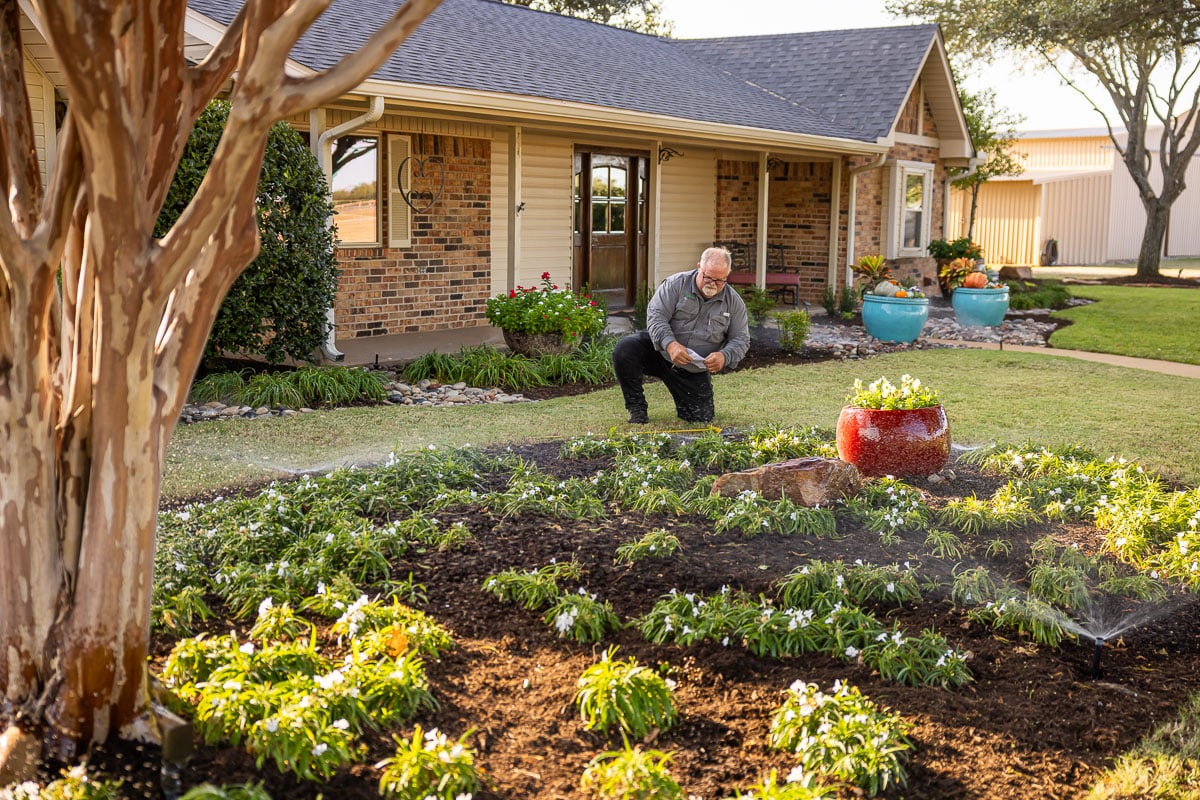
Monthly Irrigation Tasks
- Perform a Full System Audit– Run your entire system zone by zone to check for leaks, pressure, problems, or uneven coverage.
- Inspect Lawn and Plants for Water-Related Stress– Look for wilting, yellowing, or fungal growth. Adjust watering times accordingly to keep plants and turf healthy.
Irrigation Challenges to Watch For
- Watering Too Often or Too Little– Overwatering leads to shallow roots and disease, while underwatering causes stress and weak growth. Find the right balance for your grass type.
- Leaks and Pressure Issues– A small leak can waste gallons of water and drive up your water bill. Low pressure may indicate a hidden break in the line.
- Seasonal Adjustments– As temperatures cool, reduce watering frequency to prevent soggy soil and fungus growth. In summer, be mindful of drought conditions and follow local watering restrictions.
Seasonal Services Checklist
Keeping up with seasonal cleanups is essential for a healthy, well-maintained landscape. While your lawn may slow down in the cooler months, there’s still plenty to do. Seasonal services help prepare your yard for new growth, prevent plant stress, and keep your property looking its best.
- Trim Back Shrubs and Perennials– As plants go dormant, it’s time to prune back overgrown shrubs and cut back perennials. This encourages healthier regrowth in spring and prevents plants from becoming unruly.
- Remove Fallen Leaves and Debris– Clearing out leaves, branches, and other debris keeps your lawn from suffocating under thick layers of organic matter. Mulch-mowing moderate leaf coverage can help recycle nutrients back into the soil.
Seasonal Cleanup Challenges to Watch For
- Skipping Cleanup– Leaving piles of leaves and debris can smother your lawn, encourage pests, and create the perfect environment for mold and disease.
- Over-Pruning Can Stress Plants– While trimming is necessary, cutting back too much or at the wrong time can damage plants and reduce blooms for next season.

Seasonal Yard Care in Texas: Focus on These Main Tasks for Each Season
Texas landscapes face unique challenges throughout the year, from scorching summers to unpredictable winter weather. Staying on top of seasonal yard care in Texas helps you keep your lawn and plants healthy, resilient, and ready for next season. Here’s one key task to focus on each season:
Spring– Audit Your Irrigation System
Spring is the ideal time to inspect and adjust your irrigation system after winter dormancy. Look for leaks, clogged nozzles, and inefficient spray patterns to ensure proper water distribution. If you skipped mulching in the fall, now is your last chance to do it before the heat arrives.- Spring Tip: A thorough irrigation system maintenance check in early spring can prevent costly waste and prepare your lawn for summer.
Summer– Prevent Lawn Disease & Pests
Central Texas summers bring intense heat, which means perfect conditions for armyworms, grubs, and turf diseases. Over-fertilizing in early summer can make the problem worse, as fungus thrives in excess moisture and nitrogen. Watch for brown patches, thinning grass, or increased bird activity, and treat infestations early to prevent major damage.
- Summer Tip: Proper landscape maintenance in Central Texas includes balancing fertilization and watering to avoid creating a breeding ground for fungus.
Fall– Mulch to Protect & Nourish Your Landscape
Mulching for Texas landscapes is an essential task as temperatures begin to drop. A fresh layer of mulch helps regulate soil temperatures, conserve moisture, and suppress weeds going into winter. Focus on trees, garden beds, and exposed soil to protect your landscape from seasonal stress.
- Fall Tip: Mulching for Texas landscapes in fall improves plant health and reduces the need for frequent watering during dry spells.
Winter– Tree Cutbacks for Health & Safety
Once trees have lost their leaves, it’s easier to identify and remove broken, diseased, or weak branches. Winter pruning prevents storm damage, improves tree structure, and promotes healthy spring growth.
- Winter Tip: Following a landscape maintenance checklist in winter helps ensure trees and plants are ready to thrive in spring.
Benefits of Partnering with a Pro for Landscape Maintenance in Central Texas
Keeping up with a yard maintenance checklist can be overwhelming, especially in Central Texas, where persistent weeds and unpredictable rainfall can make landscape care a challenge. While some homeowners enjoy tackling small tasks, partnering with a professional for residential landscaping services in Waco, TX can save time, effort, and money while delivering consistent, high-quality results.

Save Time & Effort
Between work, family, and other responsibilities, most homeowners don’t have time to keep up with a full landscape maintenance checklist. Professional landscape maintenance teams handle everything from mowing and edging to fertilization and irrigation system maintenance, so you can enjoy a beautiful yard without the hassle.
Expertise in Plant Health, Irrigation, & Seasonal Care
Professionals have deep knowledge of things like Texas drought-resistant landscaping, so they can recommend choices that thrive in our climate while saving you water and maintenance costs. They also monitor and have specialized training in irrigation systems, pest control, and fertilization to prevent problems before they start.
No Need to Buy or Maintain Expensive Equipment
A well-maintained landscape requires sharpened mower blades, oil changes, and the right tools for every job. Most homeowners would need to invest a significant amount just for the basic equipment, not including maintenance costs, fuel, or more specialized equipment like aeration machines or fertilization spreaders. Hiring professionals means you don’t have to buy, store, or maintain any landscaping equipment.
Reliable Scheduling Means Consistent Results
DIY yardwork can easily fall behind schedule, leading to overgrown lawns, patchy grass, and unhealthy plants. With professional Central Texas lawn care, your landscape stays consistently maintained with expert precision, no matter how busy your schedule gets.
Partnering with Green Ackors for Landscape Maintenance Services in Waco, TX, and Surrounding Communities
When it comes to landscape maintenance in Central Texas, our team at Green Ackors would love to share more about the services we can provide. We serve Waco and surrounding communities, offering everything from lawn mowing and bed maintenance to fertilization, irrigation checks, and seasonal care. Check out a few things that make Green Ackors unique:
One Team, One Stop for Everything
Unlike most landscape maintenance providers, our team operates week to week a bit differently. We do not split lawn mowing and bed maintenance into separate crews; you get the same team every week–a team that gets to know you, your yard, and your preferences. We think this approach eliminates any “not my job” attitude between different crews and ensures that everything, from weeding to edging to shrub trimming, is handled with care. It also means that our crews are not rushing from lawn mowing job to lawn mowing job in a way that is most efficient on our end–our priority is you, the client.
We touch your landscape beds every single visit, not just once a month. This means your yard never looks neglected between visits, and you don’t have to deal with crews disrupting your schedule multiple times a week. The only time a different team than normal visits is for chemical treatments like fertilization, weed control, or pest management, as these landscape professionals have specialized knowledge and training in these areas.

Personal, Face-to-Face Service
From the very first visit, our Lawn Care Manager meets with every single new customer personally, not just a sales representative, but the person who is responsible for your landscape maintenance. This hands-on approach ensures clear communication and a smooth transition into a landscape maintenance program you can count on.
Transparent Pricing & Reliable Scheduling
We take pride in offering clear, upfront pricing with no hidden fees. Our commitment to quality and reliability means you’ll always know what to expect. If you are wondering whether Green Ackors is the right choice, try asking your neighbors! If they’re happy with their service, chances are you will be too.
Get Started with Green Ackors Today!
Keeping up with residential landscaping services in Waco, TX, can be a big task. We hope this guide helps you tackle yard maintenance in Central Texas with confidence, whether you’re managing it yourself or considering professional help.
If you’re planning to DIY, this checklist can serve as a valuable roadmap to keep your landscape looking its best. But we also know that lawn and landscape maintenance is a lot to handle, especially with the Texas heat, changing seasons, and the need for specialized care.
If you’re searching for how to choose professional maintenance near me, we’d love to talk to you about how we can help. With a dedicated and reliable team and commitment to quality and consistency, Green Ackors can help take the stress out of maintaining a beautiful yard.

Want to learn more about landscape maintenance services in Waco, TX, and surrounding communities? Get started today by filling out our contact form!
%20-%20copy.png)

